[/caption]
In the age of global light pollution, one thing both amateur and professional astronomers have in common is the need for clear, dark skies. While almost all of us are aware of the impact of light pollution when it comes to pure observing, the “light factor” plays a far more serious role when it comes to astronomical studies. But, there’s far deeper reasons for observatories to become increasingly remote.
While escaping light sources such as brightly-lit cities is mandatory for amateur astronomers and astrophotographers to enjoy their hobby, professional observatories seek some of the world’s most remote locations for other reasons. Both in studying and in astrophotography, splitting the light into its component colors – the spectra – of an object becomes important. For example, when studying a distant galaxy through spectroscopy, astronomers rely on the different lines in the spectral signature as a unique indicator of the presence of a certain chemical. Through the strengths of these lines, astronomers can then determine the chemical composition and temperature. What’s more, by noting how far to the red side of the spectrum the lines are shifted, astronomers can also determine how fast the object is moving…
And light pollution wrecks spectrographs.
Besides light pollution, other enemies of astrophotography and spectroscopy are high-flying airplanes, clouds, inclement weather and atmospheric conditions. One of the reasons the Hubble is so successful in the lack of atmosphere, and that’s the major reason why most remote observatories choose to locate on high peaks – the less atmosphere and the more stable the atmosphere, the better. In some circumstances, and for some equipment and telescopes, humidity can also be a problem. This is why remote observatories are also often located in desert regions as well. So, in a world that looks like this…
How far would you go for dark skies?
In a report done by ABC news a study has found that more than 40 per cent of Australia remains undamaged – and unpolluted – by humans. This means the “land down under” offers exciting possibilities for astronomical studies, not only from the perspective of viewing southern hemisphere skies, but doing research from a pristine location. This is why you’ll find research facilities such as the Anglo-Australian Observatory, Australia Telescope National Facility, Melbourne Observatory, Perth Observatory, Sydney Observatory, Siding Springs, Mills Cross Telescope, Paul Wild Observatory, Mount Stromlo Observatory and Southern Galactic International Telescope Facility.
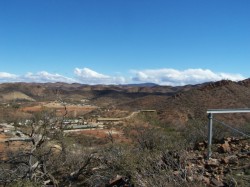
But carving the way out of the wilderness isn’t going to be easy. First a site needs to be chosen and then the logistics need to be considered. According to SG director, Dr. Bert Candusio; “The end result ultimately dictates if the effort is justified. In this case, the northern Flinders Ranges consistently proved to be the best observatory location Australia has to offer. The other factor in our site selection was availability of research support in such a remote location. Fortunately, the Arkaroola Village is fully self-contained and maintains all manner of activities from machine workshops, plant and equipment facilities all the way to visitor interpretation staff, high speed internet capabilities and support.”
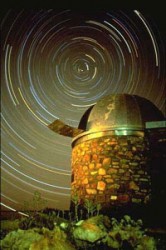
“The SG Mt. Spriggina location presents a unique opportunity for advanced research and astrophotography outcomes to organizations, educators and individuals to be operational under perhaps Australia’s foremost astromony location.” says Dr. Candusio. “The site’s uniqueness in such a remote location towards Central Australia’s wilderness has never been offered to the private and corporate sector internationally before. According to a commissioned report on the seeing quality of the northern Flinders Ranges, the area receives less cloud cover than any other region of the Australian mainland and the seeing FWHM figures were considerably better when compared to the Anglo Australia Telescope at Siding Springs location.”
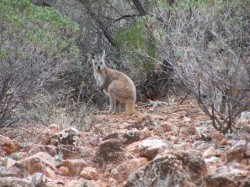 So who will be manning the telescopes in a remote observatory? Nah. As cute and cuddly as the Euro ‘roo can be, the Southern Galactic facility will offer a professionally trained support staff to oversee operations. According to Dr. Candusio, “Since Arkaroola hosts numerous visitors , there are several permanent on-site staff available to conduct tours of the existing Observatory Facilities at Arkaroola. The experience of these individuals will play a vital role in helping to keep the Mount Spriggina site functioning at all times.”
So who will be manning the telescopes in a remote observatory? Nah. As cute and cuddly as the Euro ‘roo can be, the Southern Galactic facility will offer a professionally trained support staff to oversee operations. According to Dr. Candusio, “Since Arkaroola hosts numerous visitors , there are several permanent on-site staff available to conduct tours of the existing Observatory Facilities at Arkaroola. The experience of these individuals will play a vital role in helping to keep the Mount Spriggina site functioning at all times.”
Just how far would you go?

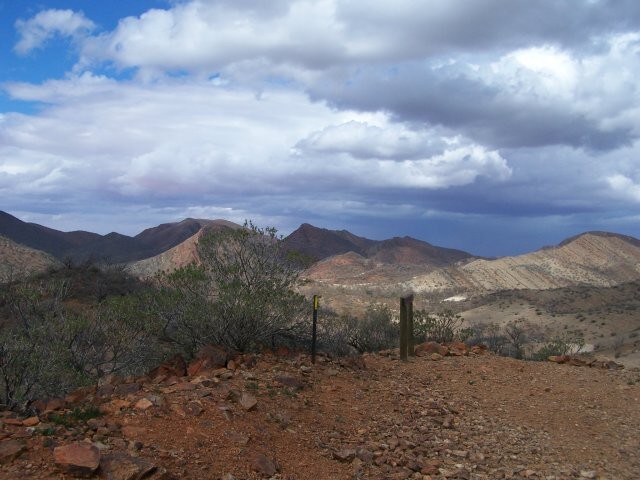
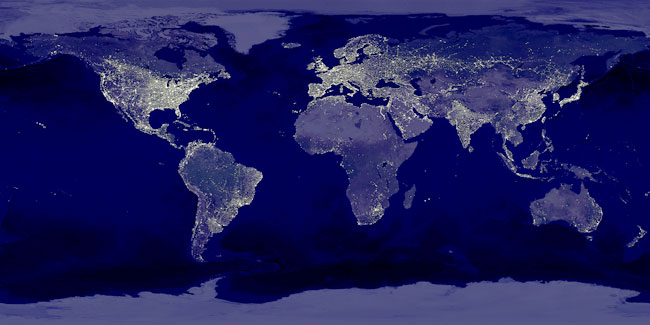
Australia is great for radio astronomy, too, since radio light pollution typically follows optical light pollution.
I remember looking up at the night sky back home when I was around 11 years old (1986), you could see countless stars and so clear. When visiting my grandparents in the village, well there was no electricity in the village so no light around. You could even see satellites points of light moving across the sky. It was amazing.
Now living in Toronto, you hardly see any stars.
Joe.
While not high up, maybe the plethora of pacific islands could be home to some telescopes. Just imagine the tag line: Work in paradise year ’round. Join the Telescope Corps and work on . Sit on beaches during the day, watch stars at night!
When I first read the title, I was thinking: “Wow, I wonder how many light years you would have to travel before all of the stars (nearly) dissapeared…”
A few more places to add.
Namibia, Chile, Canarias and perhaps Antartica. 😉
The farthest I’ve gone is a 3hr drive out of Vancouver to the east side of Manning park. Very much worth it.
@ Joe: Now living in Toronto, you hardly see any stars.
I have friends who were there during the blackout, and every one I talked to was most impressed by seeing the stars. It goes to show how rare a sight it was for them, and how they had taken it for granted that there’s just nothing much to see in the sky at night.
In the fifties as a child, I lived in Libya on a small farm near Tripoli and the night sky was fantastic. I still remember Haley’s comet.
Libya would be a good location for observatories, especially on the the Garian mountains to the south of Tripoli.
Must be another comet since Halley visited Earth in 1986 and 1910 only.
In Brazil there are still lots of dry and completely dark places.
The growing extent of light pollution is tragic. I was born and grew up in the Los Angeles Basin. As a small child — I was born in 1945 — living in San Gabriel, CA, I remember looking up at night from the backyard and seeing a wealth of stars. As time wore on and we moved to Pasadena, CA, fewer and fewer stars graced the night skies. Between the ever-growing blankets of smog that filled the Basin so much of the time and the ever-increasing sources of light at night, by the time I was 15, much of the time you could barely see *anything* in the night sky unless you were off on a camping trip into the mountains. For a while, places like Mt. Wilson and Palomar Mountain were far enough removed from city centers to be able to capture marvelous images of the heavens, but by 1960 the situation had grown so bad that the bulk of the research and funding had begun to shift to observatories based on high mountains of Hawaii, Chile, and other remote places. I yearn for the day when we will have bases, then colonies, on Luna, at least for the first few decades of our tenancy there, where there won’t be any pollution at all, not even atmosphere to make deep-sky imaging tricky.
As a former local to the Northern Flinders Ranges area, I am very aware of the frequent seismic activity there. I wonder if this could be a problem to a permanent astronomical installation.
I used to observe from my sister and husband’s home farm two miles east of town. Then the neighboring town ten miles away built a big new school and our town followed by building a new aquatic center, all complete with massive lighting. It absolutely riuned my spot.
Luckily, five miles south of where I live they own another hayfield that sits on the northern edge of the N.E. Iowa S.W. Wisconsin dark sky area. It’s a great spot that got a 21.54 dark sky reading when we had a Star BQ there Aug. 1/2.
One important factor I did not see addressed in Tammy’s otherwise finely crafted article was the importance of ‘seeing’, a measure of how steady the atmosphere is above the telescope. In much of astronomy, seeing is at least as important as transparency (darkness) in making detailed observations. Sure, Adaptive Optics (AO) exists & works fine for some objects (AO tends to limit severely the field of view of a telescope using it). But for most of the largest telescopes in the world, seeing dictates how faint a telescope can go, how accurate spectra can be obtained and other crucial data obtained by a telescope. This is why when testing sites for large telescopes, many test observations are made of the ‘seeing’ & transparency at the site. I’m sure Australia has some nights with great seeing (hence the location of the 3.6 meter AAT) but in papers discussing observations with the AAT, the numbers for seeing (usually expressed as seconds of arc) seem rather mediocre. This brings to mind the UA Flagstaff observatory & the Russian 6 meter SAO telescope. Both suffer from such poor seeing conditions, little relevant astronomical observations can be made. Poor seeing reduces a telescopes ability to see faint objects because the atmosphere smears the light from an object over several pixels on a CCD camera or spectrograph. This issue of seeing is why many of the largest scopes are found in Hawaii or Chile. While Chile may be able to stave off light pollution for several more decades, the situation in Hawaii will surely progress as it did with MT Wilson & Mt Palomar, even with Mauna Keas’ 13,000+ ft elevation. That’s why future sites for even larger telescopes are being studied around the world (even Antartica, which is dark, has very low humidity, and possibly great seeing). Also not mentioned in the article is the issue of remote observing, a growing trend among large professional telescopes. By automating a telescope & using the internet, astronomers in Germany can now remotely observe with telescopes in Chile, the Canary Islands or anywhere a robotic scope is placed. By using a small support staff at the actual observatory, its’ footprint can be reduced & astronomers needn’t travel the world over to make observations. (Sorry about the length of this post.)
I thank all of you for your kind comments.
While I am fortunate enough to live where light pollution is moderate (the small, black hole under the Great Lakes), I also yearn to be able to afford to travel to a truly remote location just to be able to see with my own eyes what “real” dark skies are. Don’t get me wrong. I am a fan of Cherry Springs, I love Glacier Point, Mt. Hamilton was incredible and I’ve been to places where you honestly needed your red flashlight just to walk safely… But never skies like I think these would be.
I, too, have watched Observatories crumble and fall over the years thanks to encroaching light pollution. One of Ohio’s deepest shames was the loss of Perkins (the “Big Ear”) and I see my own beloved Warren Rupp Observatory slowly being lost to the name of “progress”. And, yes sir. I have fought it. As more and more businesses grew along the fringes, I was there with my IDA materials and fortunate enough to have large companies cooperate – only to have smaller ones that I didn’t know about turn out to be the real light polluting culprits.
But, that’s going off topic.
To answer a few questions, here is the link to the seeing report for the new MROITF facility. While I tend to romanticize stories a bit, the stone cold heart of a scientist lurks behind the fingers on the keyboard and the link has been fixed. Having a robotic observatory available is hugely important in many senses, and if you follow some of my articles you may have noticed that I often lean on the good folks down under to chase down nova events, comets and more when skies simply do not permit from my location. My hat is simply off to them for being able to cover the sheer logistics for what it takes, eh? Here in rural Ohio, we can’t get decent hi-speed internet service, yet they’ve got T2 connect and full generator capacity a thousand miles from nowhere!
I think it’s grand that MROITF/AORAIA is expanding to two facilities that are widely spaced apart. This gives an even greater chance of catching openings in our Earth’s ever changing weather patterns. (The cardinal rule that so many do not understand is that you don’t make a date with the sky… She makes a date with you!) I know they are working hard to bring affordability of using a robotic scope into the realm of the average individual, and with a little luck (and a lot of smooth talking) we should have a UT robotic scope available by the 2009 IYA to broadcast live images for our readers.
Sound good??
😀
The link to the MROIT webpage at
http://www.darksky.net.au is flawed because
of a missing period between ” darksky”
and “net” . To reply to Joe Handford the seeing
at locations near Arkaroola has been measured
in 1994 to be an improvment over Sising Spring Obs. Its only the logistics cost That stopped
development;
For us amateurs, I’ve found places in Arizona and New Mexico to be quite adequate. I was also impressed with Alaska, although sometimes it was polluted by these pesky ‘northern lights’… 😉
Tammy, thanks for the link to the Warren Rupp Observatory. I have many fond memories of attending star parties there & using the 31″ reflector to track down many ‘faint fuzzies’. I grew up just outside of Columbus and majored in astronomy at OSU. Many more nights were spent at Perkins Observatory (which in the mid-70s had some degree of light pollution). Either under the dome of the 32″ or exposing plates with the 16″ Fecker Schmidt, the place seemed alive with the history of astronomy. Sadly, the ‘Big Ear’ radio telescope was demolished, to make way for another golf course & light pollution from Columbus & Delaware was diminishing the productivity of the optical scopes. I’m sorry to hear that the Rupp Observatory is also being affected. But I’m encouraged to hear of your involvement with the IDA and are willing to take a stand on this issue. The (dark) skies belong to everyone, yet most laypeople I talk to have never heard of light pollution and could care less about it. Astronomy needs more people like yourself to educate the general public & local governments about the problem. Some of my best observing sessions were spent at Warren Rupp & Perkins Observatory (and Cherry Springs & Mt. Hamilton), so it disheartens me to know these former dark sky sites are gone forever. Remote observing is just taking off in popularity among amateurs but it’s a poor substitute for standing under truly dark skies, a sad commentary on our times.
It truly saddens me how much light pollution there is now and it’ll continue to spread. Before you know it there will be no place on earth with dark skies and most people will forget about the stars. The stars don’t seem to exist any more, going to a remote site is easy if you have a car, walking isn’t an option because they are usually so far away. It wouldn’t surprise me if astrophotograpy could only be done with remote observatories on the moon. Light pollution is also one factor in the lack of interest in astronomy amongst young people, looking at amazing pictures is no substitute for actually being outside with the cold breeze against your face under the majesty of the night sky with thousands of stars visible. Unfortunately I have yet to experience this, the most number of stars I have seen is about 100.
When our astronomy club has outreach events, people are just amazed by what we can see with our equiptment.
But it’s a long leap from looking through a scope and thinking “Hey, that’s cool” to actually getting a decent scope or binoculars for yourself, going out there and really learning the sky.
I don’t use a Goto system (and I don’t look down on those that do, anything to get people out there) I want to learn the sky. Half the fun of finding faint fuzzies is star hopping to them on your own.
Thank God there are still dark skies somewhere.
You say in your article:
“While escaping light sources such as brightly-lit cities is mandatory for amateur astronomers and astrophotographers to enjoy their hobby…”
It is not mandatory. You can do astronomy in the middle of the city if you want. And if that is where you live, you should.
I have a small observatory just 3 miles north of the runways at Los Angeles airport (LAX), in a very light-polluted area. Yet I have taken good (not great, but decent) astrophotos from by back yard. I have also seen all the planets except Pluto (I suppose I don’t need that exception 🙂 ).
While it’s nothing like being under dark skies, we really should not give up on looking up. We need to fight pollution directly but also not give up on the joy of looking at the sky.
Examples from the light, taken from the midst of the city, at:
http://www.obsballona.com/
Oops. wrong URL
http://www.obsballona.org/
Sorry…
In looking at the night light map, I notice that Alaska and north western Canada still look pretty dark. And the area has a few mountains in it too, if memory serves. Granted that winters would be pretty extreme, but wouldn’t that be a good location for new observatories?
Note the tragic lack of light in North Korea that leaves South Korea as a brightly lit island floating in the middle of the Yellow Sea. The Earthlights picture testifies to the horrific real-life human experiment on the Korean peninsula showing how different socioeconomic and governing systems affect the well-being of the Korean people. In effect, this is a controlled experiment starting with a people who share the same history and culture and ending with greatly different results.
Hello, Jon! I am so very glad you have heard of WRO. In the last few years, we’ve come a long, long way, my friend. We’d be honored if you’d join us for a visit? Marcellus? You, too. Anytime. I’d be happy to offer you the sofa in the Clubhouse for the night.
Andy? Please don’t take a bite out of me. Not long ago I did an observing article about the partial lunar eclipse and encourage city dwellers to locate rooftops and to practice urban astronomy. Needless to say, I was taken apart by a Mr. Daniel Fischer for encouraging this practice. The post has since been (gratefully) removed (by a power higher than myself) and I still encourage folks everywhere to practice astronomy no matter what their skies are like. I will be very happy to do a very specific observing article outlining some great stuff that can be done from light polluted skies, too. I worked very hard to earn that AL Urban Observing award, and I’ll be happy to encourage others to do so, too!
And yes, my friends… The light is sad, but the very best thing we can do is to inspire and teach the generations that are coming along the importance of preserving the night skies. I also took a lot of cuts when I did the “Earth Hour” pieces, but we observed Earth Hour at the observatory during a program. While that simple gesture of doing a program by candlelight didn’t impact the Earth that much, what it did was impress 50 students that we were serious about changing tomorrow.
This is the best legacy we can leave.
Come on down to Oz
Roughly every fortnight I do round trips between Canberra and Melbourne (680 km or 8 hrs one way) and I commence these journeys in the late afternoon and arrive often after midnight. For about 2 – 3 hrs of the journey I skirt the edge of the Alpine area at around 800 – 1100 metres and I will often break the trip with a stop in the middle of nowhere to just to get out and stare opened mouthed at the magnificent sky. It really is full of stars and it never fails to move me.
When I was younger my Dad took the family on an 18mth trip round Aust trip and there were times in the Outback when I swear you could just about read by starlight.
I realise it’s important to understand what it is you are looking at but please never let all those charts etc get in the way of just revelling in the majesty of it all.
I must say, I feel exceedingly lucky to have the skies that we do here in Australia. Though I live fairly close to Sydney, passable skies are but a short trip away, moderately dark skies are 45 mins drive away, very dark skies are 2 hours away, and perfectly dark skies, covering the majority of the Australian continent, can be accessed at any time if you’re willing to make a bit of a trip out of it. Head over and check it out!
Having said this though, Australia is not a premier location for optical observatories, at least until adaptive optics technology matures further. There can be many nights of exceptional seeing in Australia, but the frequency of such would not approach that of the pristine skies around Mauna Kea or sites in Chili. Accordingly, it will be some time I think before Oz plays host to the bleeding edge optical observatories.
Radio however – that is a different story. Australia is basically the premier location on Earth for Radio observatories – it has the largest, most radio-quiet expanses of land on Earth, in a country with a highly developed economy. Hence it hosts all manner of former and present-day cutting edge radio observatories, and is the forerunner to host the Square Kilometre Array (Yieew!). ‘
So it would be fair to say that Oz doesn’t have it all in terms of astronomy, but it does very well what it does best.
Growing up in India some 30 years ago, sitting outside and looking up, I would see thousands of stars each insterspaced only a couple of cms away from each other. As a lil kid, I thought that is what I would see for the rest of my life. Although, I have to admit sometimes it was scary to just see stars all over every day.
Now I crave to get a glimpse of a bunch of them together. We have so much lighting these days, I can see nothing. I am happy that I got to experience those amazing sights in my lifetime.